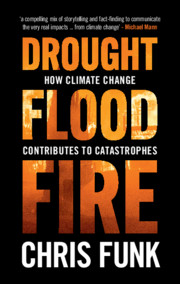Book contents
- Drought, Flood, Fire
- Drought, Flood, Fire
- Copyright page
- Contents
- Acknowledgments
- 1 Climate Extremes, Climate Attribution, Extreme Event Attribution
- 2 Welcome to an Awesome Planet
- 3 The Earth Is a Negentropic System, or “the Bright Side of Empty”
- 4 Do-It-Yourself Climate Change Science
- 5 Temperature Extremes – Impacts and Attribution
- 6 Precipitation Extremes
- 7 Hurricanes, Cyclones, and Typhoons
- 8 Conceptual Models of Climate Change and Prediction, and How They Relate to Floods and Fires
- 9 Climate Change Made the 2015–2016 El Niño More Extreme
- 10 Bigger La Niñas and the East African Climate Paradox
- 11 Fire and Drought in the Western United States
- 12 Fire and Australia’s Black Summer
- 13 Driving toward +4°C on a Dixie® Cup Planet
- 14 We Can Afford to Wear a White Hat
- Appendix A Few Resources for Further Reading and Research
- Index
6 - Precipitation Extremes
Observations and Impacts
Published online by Cambridge University Press: 01 June 2021
- Drought, Flood, Fire
- Drought, Flood, Fire
- Copyright page
- Contents
- Acknowledgments
- 1 Climate Extremes, Climate Attribution, Extreme Event Attribution
- 2 Welcome to an Awesome Planet
- 3 The Earth Is a Negentropic System, or “the Bright Side of Empty”
- 4 Do-It-Yourself Climate Change Science
- 5 Temperature Extremes – Impacts and Attribution
- 6 Precipitation Extremes
- 7 Hurricanes, Cyclones, and Typhoons
- 8 Conceptual Models of Climate Change and Prediction, and How They Relate to Floods and Fires
- 9 Climate Change Made the 2015–2016 El Niño More Extreme
- 10 Bigger La Niñas and the East African Climate Paradox
- 11 Fire and Drought in the Western United States
- 12 Fire and Australia’s Black Summer
- 13 Driving toward +4°C on a Dixie® Cup Planet
- 14 We Can Afford to Wear a White Hat
- Appendix A Few Resources for Further Reading and Research
- Index
Summary
Linking a warming atmosphere, droughts, and more extreme precipitation is our thin, thin atmosphere. If the Earth were a basketball, the atmosphere would be 0.03-inch or 0.8-mm thick, literally whisker deep. The amount of water vapor contained in this air is strongly controlled by temperature. Warmer air holds more atmospheric water vapor, resulting in more extreme precipitation. Rainfall observations indicate that global precipitation extremes have already increased by more than 8 percent. If the observed trend continues, a similar-magnitude increase is likely over the next thirty years. This is very concerning, because extreme precipitation events are already extremely dangerous and costly. Between 1998 and 2017, floods, storms, and hurricanes affected more people than any other type of disaster, impacting 2.7 billion people overall resulting in $1.99 trillion of recorded economic losses. 2015–2019 disaster data suggests that the most dangerous non-cyclone storms affected 223 million people, led to more than 9,000 deaths, and resulted in $80 billion in damages. There is solid observational and model-based evidence supporting the link between a warming atmosphere and more intense precipitation extremes, and clear evidence that these extremes are having deadly and costly impacts today.
Keywords
- Type
- Chapter
- Information
- Drought, Flood, FireHow Climate Change Contributes to Catastrophes, pp. 122 - 139Publisher: Cambridge University PressPrint publication year: 2021
- 1
- Cited by

